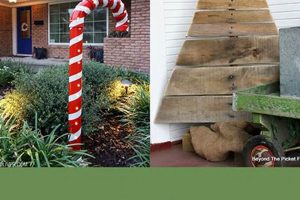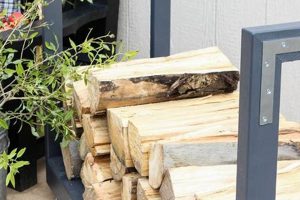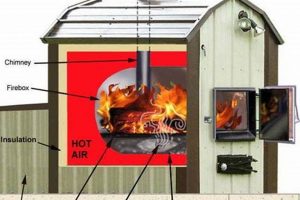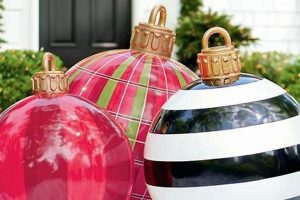The practice of creating personalized external holiday illuminations involves individuals crafting unique displays using electric lights and various materials to adorn the exterior of homes and properties during the Christmas season. These projects range from simple string light arrangements to elaborate, custom-built figures and scenes. For example, a homeowner might construct a starburst design using wire hangers and LED light strings or fashion illuminated reindeer figures from repurposed wood and chicken wire.
Implementing bespoke festive illuminations offers several advantages, including cost savings compared to professional installations, the opportunity for creative expression, and increased neighborhood engagement. Historically, outdoor Christmas lighting evolved from placing candles in windows to the widespread adoption of electric lights in the early 20th century. The shift empowered individuals to showcase their personal style and contribute to the collective holiday atmosphere of their communities.
The following sections will explore specific design ideas, safety considerations, material selection, and step-by-step instructions for crafting impressive and enduring outdoor Christmas light displays. Information about energy-efficient lighting options and maintenance techniques will also be provided to ensure both visual appeal and responsible resource utilization.
Illumination Creation Strategies
Effective implementation of external festive illuminations requires careful planning and execution. The following guidance ensures both aesthetic appeal and operational safety.
Tip 1: Prioritize Safety: Before commencing any project, thoroughly inspect all electrical components for damage. Utilize only outdoor-rated extension cords and light strings certified by a recognized testing laboratory. Ground Fault Circuit Interrupter (GFCI) protection is essential for all outdoor outlets.
Tip 2: Plan the Layout: Develop a detailed plan outlining the placement of lights and decorations. Consider the architectural features of the property and the desired visual impact. Use a sketch or digital tool to visualize the final arrangement before installation begins.
Tip 3: Select Energy-Efficient Lighting: Opt for LED light strings to minimize energy consumption and reduce electricity costs. LEDs also generate less heat, lowering the risk of fire hazards. Compare wattage ratings when making purchasing decisions.
Tip 4: Secure Lighting Properly: Utilize appropriate clips, stakes, or fasteners designed for outdoor use to secure light strings and decorations. Avoid using nails or staples, which can damage the wiring insulation. Ensure that lights are securely attached to prevent them from falling due to wind or inclement weather.
Tip 5: Consider a Timer: Employ a timer to automatically turn lights on and off, conserving energy and extending the lifespan of the bulbs. Program the timer to operate during peak viewing hours.
Tip 6: Protect Connections: Shield all electrical connections from moisture by using weatherproof connectors or wrapping them securely with electrical tape. This prevents short circuits and ensures reliable operation throughout the holiday season.
Tip 7: Test Before Final Installation: Before fully installing any light display, test all components to ensure they are functioning correctly. Replace any defective bulbs or sections of light string before proceeding with the final arrangement.
Adhering to these guidelines promotes both visually appealing and safe outdoor festive illuminations. Diligent planning and meticulous execution are crucial for a successful display.
The subsequent section will provide information on maintaining festive illumination displays throughout the holiday season, further enhancing their longevity and visual impact.
1. Planning
Detailed planning serves as the cornerstone of successful external holiday illumination projects. The absence of a comprehensive strategy frequently results in inefficient resource allocation, increased project costs, and compromised safety. Pre-emptive planning involves assessing the available space, determining desired aesthetic outcomes, calculating material requirements, and identifying potential electrical hazards. For instance, a homeowner who fails to accurately measure the length of their roofline may purchase insufficient light strings, leading to project delays and additional expense. Similarly, inadequate planning may overlook the need for supplementary power outlets, necessitating costly electrical modifications.
Effective planning mitigates risks and enhances the overall effectiveness of exterior holiday installations. A well-defined plan incorporates a scaled diagram of the property, illustrating the placement of lights and decorations. This diagram enables precise material procurement, minimizes waste, and facilitates efficient installation. For example, a plan specifying the use of different colored lights to highlight architectural features requires a detailed inventory of bulb quantities and wiring configurations. Furthermore, strategic placement of decorations, guided by a comprehensive plan, optimizes visual impact while adhering to safety regulations and property line restrictions.
In conclusion, meticulous planning is integral to the realization of impactful and safe external holiday light displays. This process minimizes unforeseen expenses, streamlines installation procedures, and ensures alignment between desired aesthetic outcomes and practical implementation. Prioritizing planning enhances project efficiency and contributes to the overall success of festive external lighting endeavors.
2. Safety
The integration of safety protocols within the construction of individualized external festive illuminations is paramount. These safety measures directly impact the well-being of individuals and the structural integrity of properties.
- Electrical Grounding
Proper electrical grounding is critical to prevent electric shock hazards. Grounding ensures that stray electrical currents are safely diverted, minimizing the risk of electrocution should a fault occur within the lighting system. For example, using a Ground Fault Circuit Interrupter (GFCI) outlet provides an additional layer of protection by immediately cutting off power in the event of a ground fault.
- Weather Resistance
Ensuring that all electrical components are rated for outdoor use is essential. Weather-resistant light strings, extension cords, and connectors are designed to withstand exposure to rain, snow, and ice, preventing short circuits and potential fires. An example includes the selection of UL-listed lights specifically designated for external applications.
- Load Management
Overloading electrical circuits can lead to overheating and fire hazards. Calculating the total wattage of all connected lights and ensuring that it does not exceed the capacity of the circuit is crucial. The use of multiple circuits or timers can help to distribute the electrical load and prevent overloads.
- Secure Mounting
Properly securing light strings and decorations prevents them from falling and causing injury or damage. Using appropriate clips, hooks, or stakes designed for outdoor use ensures that lights remain securely attached to surfaces, even in windy conditions. Incorrect mounting methods, such as using nails or staples directly through wires, can compromise insulation and create electrical hazards.
These facets of safety collectively underscore the necessity for meticulous planning and execution in the creation of exterior holiday light arrangements. Prioritizing electrical grounding, weather resistance, load management, and secure mounting methods enhances the safety and longevity of individualized external illumination projects, while mitigating potential risks to individuals and properties. Proper attention to these factors is not merely a recommendation but an imperative for responsible festive illumination practices.
3. Materials
The selection of appropriate materials directly influences the aesthetic appeal, durability, and safety of external festive illuminations. The correlation between material choice and the longevity of these projects is significant; inferior materials often degrade rapidly when exposed to environmental elements, leading to premature failure and increased maintenance costs. Conversely, high-quality, weather-resistant materials enhance the visual impact and extend the lifespan of the display. For example, using LED light strings instead of incandescent bulbs reduces energy consumption and minimizes the risk of overheating, while outdoor-rated extension cords offer superior protection against moisture and electrical hazards. The type of fasteners used to secure light strings, such as UV-resistant clips, prevents them from becoming brittle and breaking under sunlight exposure, ensuring that the lights remain securely in place throughout the holiday season.
Furthermore, material choices impact the ease of installation and subsequent dismantling of festive lighting displays. Lightweight materials, such as PVC frames for creating illuminated figures, simplify construction and reduce the strain on supporting structures. The use of modular components allows for easy reconfiguration and storage of the decorations, providing flexibility in design and simplifying the post-holiday takedown process. Consider the selection of materials when building a lighted star for the front yard; a metal frame will be more durable than a cardboard one, especially when exposed to harsh weather conditions. Similarly, the type of wire used for creating custom light designs should be chosen based on its flexibility, strength, and resistance to corrosion.
In summation, the careful selection of materials is paramount to achieving visually impressive, durable, and safe external festive illuminations. Choosing materials with appropriate weather resistance, weight, and ease of installation ensures that the light display withstands the environmental challenges of the season while minimizing the risk of electrical hazards. Investing in quality materials offers long-term cost savings and reduces the need for frequent repairs or replacements, contributing to a more sustainable and enjoyable holiday decorating experience.
4. Creativity
Creativity serves as the driving force behind individualized external holiday illuminations, transforming routine displays into unique expressions of festive spirit. It dictates the aesthetic character, the level of personalization, and the overall impact of the installation.
- Theme Development
Theme development provides a cohesive narrative framework for external holiday lighting. Themes can range from traditional depictions of nativity scenes to contemporary interpretations of winter wonderlands. For example, a homeowner might choose a “North Pole Workshop” theme, incorporating animated elves, candy cane pathways, and an illuminated Santa’s sleigh. Thematic consistency elevates a display from a collection of lights to a unified visual story.
- Material Innovation
Material innovation involves the unconventional use of common materials to create unique decorative elements. Examples include crafting snowflakes from recycled plastic bottles, constructing illuminated reindeer from repurposed wooden pallets, or fashioning glowing orbs from chicken wire and fabric. This approach fosters resourcefulness and reduces environmental impact while adding distinctive character to the display.
- Lighting Techniques
Creative lighting techniques extend beyond simple string light arrangements. Experimentation with color gradients, light patterns, and projection effects can produce striking visual results. Employing programmable LED controllers allows for dynamic light shows synchronized with music, adding an interactive dimension to the external display. Strategic spotlighting can accentuate architectural features or highlight specific decorations, creating depth and visual interest.
- Spatial Design
Spatial design considers the arrangement of lights and decorations within the available outdoor space to maximize visual impact. Careful consideration of scale, perspective, and focal points contributes to a balanced and aesthetically pleasing composition. Layering different types of lights, such as string lights, spotlights, and pathway lights, creates depth and dimension. Integrating natural elements, such as trees and shrubs, into the design enhances the overall visual harmony.
The incorporation of these creative elements transforms typical external holiday illuminations into personalized works of art. Theme development, material innovation, lighting techniques, and spatial design converge to create memorable and visually compelling displays that reflect the individual tastes and artistic sensibilities of the creator. The ability to exercise creative freedom is a primary motivator for individuals engaging in the construction of bespoke festive lighting projects.
5. Efficiency
Efficiency in external festive illuminations refers to the minimization of resource expenditureenergy, time, and materialswhile maximizing aesthetic impact and functionality. This consideration is increasingly pertinent, aligning with environmental awareness and economic prudence. Optimizing efficiency ensures both visually appealing displays and responsible resource utilization.
- Energy Consumption Minimization
The selection of lighting technology directly influences energy efficiency. Replacing traditional incandescent bulbs with Light Emitting Diodes (LEDs) reduces power consumption by up to 90% for equivalent illumination. For example, a string of 100 incandescent bulbs consumes approximately 40 watts, while a comparable LED string uses only 4 watts. Dimming controls and timers further optimize energy usage by regulating light intensity and operating hours, aligning illumination with actual need and reducing wasted energy during periods of low visibility or inactivity.
- Material Optimization and Waste Reduction
Efficient material usage minimizes waste and reduces project costs. Accurate measurement and planning prevent unnecessary material purchases. Repurposing existing materials, such as recycling plastic bottles into decorative elements, minimizes landfill waste. Employing durable materials extends the lifespan of the display, reducing the need for frequent replacements. For example, constructing frames from treated lumber ensures resistance to rot and insect damage, extending the structure’s usability over multiple seasons.
- Installation Time Optimization
Streamlining the installation process conserves time and labor. Modular designs, pre-fabricated components, and standardized mounting systems accelerate setup. For example, using clip-on light strings instead of individually attaching each bulb reduces installation time significantly. Careful planning, including pre-assembly and organization of materials, minimizes delays and maximizes productivity during the installation phase.
- Operational Longevity and Maintenance Reduction
Durable materials and weather-resistant construction techniques extend the operational lifespan of external festive illuminations and reduce the frequency of maintenance. Selecting corrosion-resistant fasteners and UV-resistant wiring protects against environmental degradation. Implementing a regular inspection and maintenance schedule, including bulb replacement and cleaning, prevents minor issues from escalating into major repairs. Extended operational longevity equates to reduced material replacements and operational costs.
The integration of efficiency principles into the creation of external festive illuminations enhances both economic and environmental sustainability. By prioritizing energy conservation, minimizing material waste, streamlining installation processes, and extending operational lifespans, individuals can create impactful holiday displays while minimizing their resource footprint. Adherence to efficiency principles represents a responsible approach to festive decoration.
6. Durability
The longevity of individualized external festive lighting displays is intrinsically linked to the concept of durability, representing the capacity of the decorations to withstand environmental stressors and maintain their aesthetic integrity over extended periods. Premature degradation of materials, resulting from exposure to weather elements such as rain, snow, ultraviolet radiation, and temperature fluctuations, directly undermines the visual appeal and operational functionality of these creations. Selecting durable materials and construction techniques, therefore, is paramount to ensuring the long-term success and cost-effectiveness of outdoor holiday illumination endeavors. For instance, light strings utilizing UV-resistant insulation prevent cracking and discoloration, while waterproof connectors mitigate the risk of electrical shorts caused by moisture penetration. Structures built from treated lumber resist rot and insect infestation, extending their lifespan compared to untreated alternatives.
The correlation between durability and safety is also noteworthy. Deteriorated wiring, weakened support structures, or corroded electrical components pose significant safety risks, potentially leading to electrical shocks, fire hazards, or structural collapses. Incorporating robust materials and construction methods enhances the resilience of the display, reducing the likelihood of safety-related incidents. Consider a scenario where a homeowner constructs a large illuminated star using untreated wood. Over time, the wood may warp, crack, and become susceptible to insect damage, compromising the structural integrity of the decoration and increasing the risk of collapse in windy conditions. By contrast, a star constructed with weather-resistant materials and reinforced joints will withstand environmental stresses and maintain its structural stability, ensuring the safety of individuals and property.
In summary, durability represents a critical component of successful external festive lighting displays. Prioritizing durable materials and construction techniques translates to increased longevity, reduced maintenance costs, enhanced safety, and improved overall aesthetic appeal. Understanding the importance of durability enables individuals to create impactful and enduring outdoor holiday illuminations that can be enjoyed for years to come, contributing to a more sustainable and cost-effective festive decorating experience. Neglecting durability considerations, conversely, may result in premature failure, increased expenses, and potential safety hazards, detracting from the overall enjoyment of the holiday season.
7. Installation
The installation phase is a critical determinant of the overall success and longevity of individualized external festive lighting. The manner in which these decorations are affixed to a property directly impacts their visual presentation, structural integrity, and potential safety risks. Improper installation can negate even the most creative designs and high-quality materials. For example, failing to securely fasten light strings to a roofline may result in drooping lines, uneven illumination, and potential detachment during adverse weather conditions, undermining the aesthetic appeal of the display. Furthermore, incorrect wiring practices or overloading electrical circuits during installation can create fire hazards, jeopardizing property and personal safety.
Effective installation necessitates adherence to established safety protocols and best practices. This includes the use of appropriate fasteners, such as non-corrosive clips and anchors designed for outdoor use, to securely attach lights to various surfaces without damaging the underlying materials. Consideration must be given to the weight and wind resistance of decorations to prevent collapse or displacement. Strategically positioning lights to accentuate architectural features or create focal points requires careful planning and execution during installation. The integration of timers and control systems, if applicable, must be implemented correctly to ensure proper operation and energy efficiency. As an illustration, consider the installation of a large illuminated star on a gable. If the star is not adequately supported, wind forces can cause it to sway and potentially detach, posing a hazard to passersby and damaging the structure itself. Conversely, a properly installed star, securely anchored and braced, will withstand environmental stresses and maintain its position throughout the holiday season.
In conclusion, the installation process represents a crucial link in the chain of creating successful external festive illuminations. It serves as the culmination of planning, material selection, and creative design, transforming abstract concepts into tangible realities. Attentive adherence to safety guidelines, proper fastening techniques, and strategic positioning practices ensures both the visual impact and the long-term stability of the display. The success or failure of external festive lighting often hinges on the quality and care invested in the installation phase, underscoring its pivotal role in achieving a festive and safe holiday season.
Frequently Asked Questions Regarding External Holiday Illumination Projects
The following questions and answers address common concerns and misconceptions related to the planning, execution, and maintenance of personalized external holiday light arrangements.
Question 1: What are the fundamental safety precautions that must be observed when installing outdoor Christmas lights?
Ensuring safety involves the use of Ground Fault Circuit Interrupter (GFCI) outlets, adherence to recommended wattage limits for electrical circuits, utilization of outdoor-rated extension cords, and securing light strings with appropriate clips to prevent falls and potential hazards. Furthermore, it is imperative to inspect all electrical components for damage prior to installation to mitigate the risk of electrical shock or fire.
Question 2: What are the advantages of using LED lights as opposed to traditional incandescent bulbs for holiday displays?
LEDs offer significant advantages over incandescent bulbs, including substantially lower energy consumption, extended lifespan, reduced heat emission, and enhanced durability. The adoption of LEDs minimizes energy costs, reduces the risk of overheating and fire hazards, and contributes to a more sustainable and environmentally conscious approach to holiday lighting.
Question 3: How does weatherproofing enhance the durability and safety of external holiday light installations?
Weatherproofing protects electrical components from moisture intrusion, preventing short circuits, corrosion, and electrical hazards. The use of waterproof connectors, insulated wiring, and weather-resistant housings ensures the reliable and safe operation of the lighting system under various environmental conditions, extending its lifespan and minimizing the risk of failure.
Question 4: What are the crucial factors to consider when planning the layout and design of an outdoor Christmas light display?
Effective planning involves assessing the architectural features of the property, determining the desired visual impact, calculating the required amount of lighting, and considering the accessibility of power sources. Careful consideration of these factors contributes to a well-balanced, aesthetically pleasing, and structurally sound display that complements the property’s existing attributes.
Question 5: How can energy consumption be further minimized when operating outdoor Christmas lights?
Energy consumption can be optimized through the implementation of timers that automatically turn lights on and off during specified hours. Utilizing dimming controls to reduce light intensity during off-peak viewing times, and opting for solar-powered lighting options where appropriate, can further minimize energy waste and promote sustainable practices.
Question 6: What are the recommended maintenance procedures for ensuring the longevity and safety of outdoor Christmas lights?
Regular maintenance involves inspecting light strings for damaged or frayed wires, replacing burned-out bulbs promptly, cleaning light fixtures to remove dirt and debris, and ensuring that all connections remain secure and weatherproof. Periodic inspections and timely repairs prevent minor issues from escalating into major problems, extending the lifespan of the display and minimizing safety risks.
Adhering to these considerations is crucial for the successful and safe implementation of external holiday illumination projects. Diligent planning and responsible execution are essential for achieving both visual appeal and operational integrity.
The subsequent section will explore advanced techniques for controlling and automating external festive illumination displays, further enhancing their impact and functionality.
Conclusion
“diy outdoor christmas light decorations” encompass a multifaceted discipline, demanding meticulous planning, vigilant safety implementation, discerning material selection, and inventive design. This exploration has underscored the importance of each element, emphasizing the interconnectedness of efficiency, durability, and aesthetic appeal. Neglecting any of these facets risks compromising the overall success and longevity of such projects.
The responsible execution of “diy outdoor christmas light decorations” signifies more than mere festive adornment; it represents a commitment to resource conservation, safety, and community engagement. Individuals should approach these endeavors with a deliberate understanding of their environmental impact and a dedication to upholding the highest standards of safety and craftsmanship. The future of external holiday illuminations lies in innovation, sustainability, and a continued focus on responsible execution.







